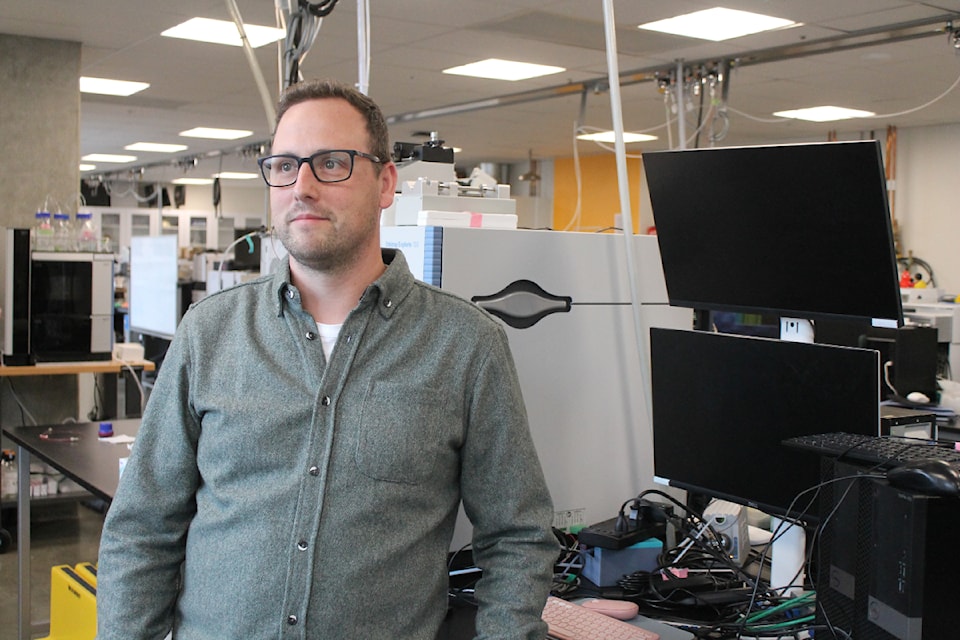Science
Researchers Innovate to Combat Cancer Tumour Resistance

A research initiative at Vancouver Island University, led by Professor Kyle Duncan, aims to uncover the reasons behind the resistance of certain cancerous tumours to immunotherapies. This project, which began in 2023, seeks to enhance treatment effectiveness by creating custom machinery and tools that analyze tumour metabolism.
The research focuses on tumours associated with pancreatic, ovarian, and pediatric bone cancers, all of which are known for being under-diagnosed and challenging to treat with conventional therapies. Emerging from funding from the Terry Fox Research Institute and the Michael Smith Health Research B.C. scholar program, Duncan’s team is tasked with developing a detailed molecular map of these tumours to relay important data to teams administering immunotherapies.
“Immunotherapies are a promising treatment, but solid tumours are sometimes resistant,” Duncan stated. “It’s unclear why these treatments only work for some people.” This research aims to bridge the gap between chemistry, biology, and engineering to design specialized equipment that can analyze molecular interactions at a cellular level.
Custom Engineering for Enhanced Analysis
Traditionally, the analysis of tumour samples involved grinding them into a paste, which provided information on the abundance of molecules but failed to capture how these molecules interacted within the complex tissue. Duncan’s team is addressing this limitation by constructing custom instrumentation that allows for the mapping of tissue samples in a more contextually rich manner.
To achieve this, the team slices the tissue into thin sections, roughly one cell thick, and interfaces this with a state-of-the-art mass spectrometer. The technique incorporates glass capillaries that are aligned to create a continuous liquid bridge between two tubes. The liquid removes molecules from the tissue surface, transferring them into the spectrometer for analysis, ultimately generating a molecular ‘fingerprint’.
“This process requires precision at the micrometre scale, necessitating fine control mechanisms in three dimensions,” Duncan explained. “Our goal is to understand the contextual distribution of molecules throughout the tumour and identify the micro-environments that hinder immune cell efficacy.”
Future Prospects and Accessibility
As the project progresses, Duncan envisions automating the analysis process to enhance efficiency. Currently, a team member must manually oversee the machine for seven hours daily to create the molecular maps. “Ideally, we would like to automate this process,” he said. “The dream is to simply place the tissue section on the holder and press go.”
Despite the challenges posed by the pioneering nature of their equipment, which is still in its early stages of development, Duncan is optimistic. “Technical barriers exist, such as alignment issues with the capillaries, but we are committed to refining our approach,” he noted.
Once completed, all data and designs generated from this research will be made publicly available, promoting transparency and collaboration in the scientific community. More information about the project can be found on Duncan’s website at http://wordpress.viu.ca/duncan.
This innovative work at Vancouver Island University not only seeks to advance cancer treatment but also aims to illuminate the complexities of tumour biology, potentially leading to more effective therapies for patients facing these challenging cancers.
-

 Politics4 weeks ago
Politics4 weeks agoSecwepemc First Nation Seeks Aboriginal Title Over Kamloops Area
-

 World5 months ago
World5 months agoScientists Unearth Ancient Antarctic Ice to Unlock Climate Secrets
-

 Entertainment5 months ago
Entertainment5 months agoTrump and McCormick to Announce $70 Billion Energy Investments
-

 Science5 months ago
Science5 months agoFour Astronauts Return to Earth After International Space Station Mission
-

 Lifestyle5 months ago
Lifestyle5 months agoTransLink Launches Food Truck Program to Boost Revenue in Vancouver
-

 Technology3 months ago
Technology3 months agoApple Notes Enhances Functionality with Markdown Support in macOS 26
-

 Lifestyle3 months ago
Lifestyle3 months agoManitoba’s Burger Champion Shines Again Amid Dining Innovations
-

 Top Stories2 months ago
Top Stories2 months agoUrgent Update: Fatal Crash on Highway 99 Claims Life of Pitt Meadows Man
-

 Politics4 months ago
Politics4 months agoUkrainian Tennis Star Elina Svitolina Faces Death Threats Online
-

 Sports5 months ago
Sports5 months agoSearch Underway for Missing Hunter Amid Hokkaido Bear Emergency
-

 Politics5 months ago
Politics5 months agoCarney Engages First Nations Leaders at Development Law Summit
-

 Technology5 months ago
Technology5 months agoFrosthaven Launches Early Access on July 31, 2025



















